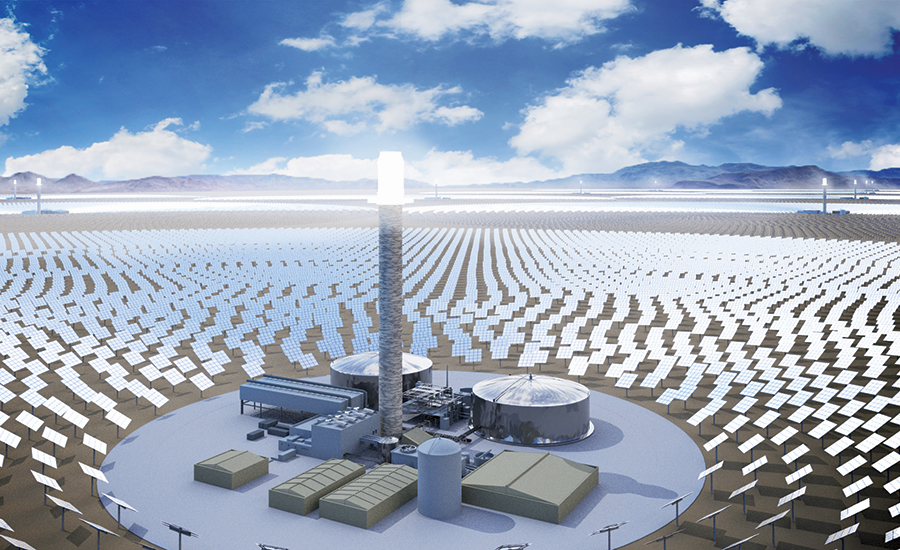SolarReserve LLC, a privately owned company based in Santa Monica, Calif., plans to make a final decision in the next six months on a site in Nye County, Nev., for what would be the world’s largest solar power plant.
If SolarReserve is able to secure needed federal and local permits and arrange financing, its Sandstone Energy 10X project would be built in phases and, when finished, be capable of generating up to 2,000 MW—as much as some of the largest gas-fired plants and nuclear power stations.
Sandstone would not be a standard solar farm with arrays of photovoltaic panels. It would be one of only three concentrating solar power (CSP) plants in the U.S. with a power tower and only the second to use molten salt to store energy.
CSP plants gather and focus the sun’s energy to heat a fluid that is used to drive an engine that produces electricity. There are about two dozen CSPs in the U.S., but only two of them use power-tower technology. Further, only SolarReserve’s 110-MW Crescent Dunes CSP plant in Tonopah, Nev., uses molten salt to extend the plant’s generating capacity into the night.
The CSP portion uses an array of heliostats, which are curved mirrors, to focus sunlight on a tank that sits atop a tower. The Sandstone project calls for thousands of heliostats, each 37 ft wide and 34 ft tall. The focused heat can turn water into steam or, in SolarReserve’s case, melt salt and store it at 566°C.
The molten salt is circulated from the tower to the steam turbine and pumped back up to the tower. The plant is designed so that the salt is molten for the life of the project, never falling below 260°C.
The heat from the molten salt enables the plant to generate at full power for up to 10 hours into the night. In one test, the plant was able to generate power for 24 hours continuously, says SolarReserve spokeswoman Mary Grikas.
A CSP power tower is simple in concept, but execution has proved to be more difficult, at least in one notable case. The 392-MW Ivanpah CSP plant in California’s Mojave Desert, near Las Vegas, uses water, not molten salt, which would seem to make for a simpler project. But since entering service in 2014, Ivanpah has suffered a fire, production problems and criticism, specifically for the 450-ft-high tower killing birds with its focused, high-intensity sunlight. The project’s problems even prompted speculation that it could signal the end for CSP projects.
The fire at the plant, which is owned by NRG Energy, BrightSource Energy and Google, started not because of an operational problem but because heliostats were locked in place in preparation for maintenance work. Those preparations inadvertently locked the heliostats, which focused the sun’s rays on cables in the tower’s lattice work, starting the fire.
To reduce bird deaths, the owners are refocusing the heliostats to narrow the beam of energy, or flux, they produce and experimenting with scents that repel birds, among other measures.
Low power production was caused by unexpected cloud cover. The owners have negotiated a forbearance agreement with Pacific Gas & Electric, the purchaser of the plant’s electrical output. The system employs software that controls the heliostats, making them less sensitive to passing clouds.
“We have seen significant improvement in Ivanpah’s performance in 2015 and 2016, and while we are still in the four-year ramp-up, we are frequently seeing energy production levels at or above predicted levels for mature operations,” says David Knox, a spokesman for NRG, the plant’s operator.
“Without storage, you are so dependent on when the sun is shining, and you have to deal with issues when it is not,” Grikas says. Storage allows the plant to be operated more like a conventional power plant, she says. Sandstone’s 640-ft towers—the project calls for 10 of them—will be made of concrete, so they are not as liable to catch fire, she noted.
The developer also is working on mitigating bird deaths, starting with selecting a site with less bird traffic.
That site, which will require 15,000 to 20,000 acres, likely will be on federal land. If all goes to plan, construction could begin in two or three years, Grikas says.





